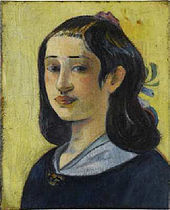Paul Gauguin
Eugne Henri Paul Gauguin was a French postImpressionist artist. Underappreciated until after his death, Gauguin is now recognized for his experimental use of color and synthetist style that were distinctly different from Impressionism. His work was influential to the French avantgarde and many modern artists, such as Pablo Picasso and Henri Matisse. Gauguins art became popular after his death, partially from the efforts of art dealer Ambroise Vollard, who organized exhibitions of his work late in his career, as well as assisting in organizing two important posthumous exhibitions in Paris. Many of his paintings were in the possession of Russian collector Sergei Shchukin as well as other important collections.
Gauguin was born in Paris, France, to journalist Clovis Gauguin and Alina Maria Chazal, daughter of the protosocialist leader Flora Tristan, a feminist precursor whose father was part of an influential Peruvian family. In 1850, the family left Paris for Peru, motivated by the political climate of the period. Clovis died on the voyage, leaving 18monthold Paul, his mother and sister, to fend for themselves. They lived for four years in Lima with Pauls maternal uncle and his family. The imagery of Peru would later influence Gauguin in his art. It was in Lima that Gauguin encountered his first art. His mother admired PreColumbian pottery, collecting Inca pots that some colonists dismissed as barbaric. Later in life and due to his fascination with ancient Peruvian cultures, Gauguin would create more thanworks of art inspired by a Peruvian, preIncan mummy.
Source: Wikipedia

